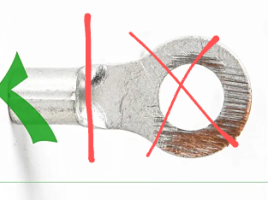Frank Langer
1984 Ericson 30+, Nanaimo, BC
Hi,
I try to do as many of my own repairs as possible, but this one is tricky, so advice and suggestions would be very helpful.
The 20 year old ST40 wind instrument/anemometer is showing erratic wind speeds. Raymarine tech says it's the pod containing a small circuit board at the mast head. I got up there, took apart the instrument, found the pod, cleaned it all with electrical cleaner, but it's still erratic.
I found a replacement pod in England, which looks like the circuit part, so I'm heading back up the mast tomorrow to hopefully fix it.
My problem is that the wire to the two small prongs on the pod is AWG 22, so very thin with only a few strands, and there is only about an inch extra sticking out the top of the mast, so how to connect. I'm considering stripping and soldering it, but have only limited experience soldering many years ago, and I'll be at the top of the mast with the boat bouncing in light waves. I don't know If I have enough wire to do a crimp in the existing wire and attach a small extra wire to solder to the prongs, the connection could be a bullet crimp.
Any other ideas? A replacement instrument is over $1,000 and might require running wires down the deck stepped mast, drilling new holes, etc., not a good option. I sailed for years without a wind instrument, so that might be a possibility, but knowing wind speed helps me make decisions on reefing, etc.
Thanks for any advice.
Frank
I try to do as many of my own repairs as possible, but this one is tricky, so advice and suggestions would be very helpful.
The 20 year old ST40 wind instrument/anemometer is showing erratic wind speeds. Raymarine tech says it's the pod containing a small circuit board at the mast head. I got up there, took apart the instrument, found the pod, cleaned it all with electrical cleaner, but it's still erratic.
I found a replacement pod in England, which looks like the circuit part, so I'm heading back up the mast tomorrow to hopefully fix it.
My problem is that the wire to the two small prongs on the pod is AWG 22, so very thin with only a few strands, and there is only about an inch extra sticking out the top of the mast, so how to connect. I'm considering stripping and soldering it, but have only limited experience soldering many years ago, and I'll be at the top of the mast with the boat bouncing in light waves. I don't know If I have enough wire to do a crimp in the existing wire and attach a small extra wire to solder to the prongs, the connection could be a bullet crimp.
Any other ideas? A replacement instrument is over $1,000 and might require running wires down the deck stepped mast, drilling new holes, etc., not a good option. I sailed for years without a wind instrument, so that might be a possibility, but knowing wind speed helps me make decisions on reefing, etc.
Thanks for any advice.
Frank
Last edited:

